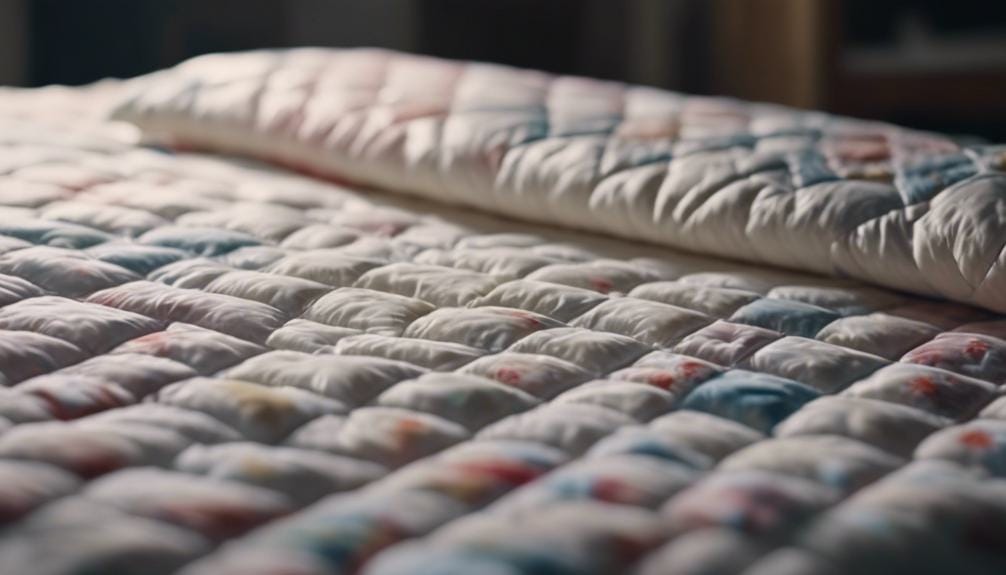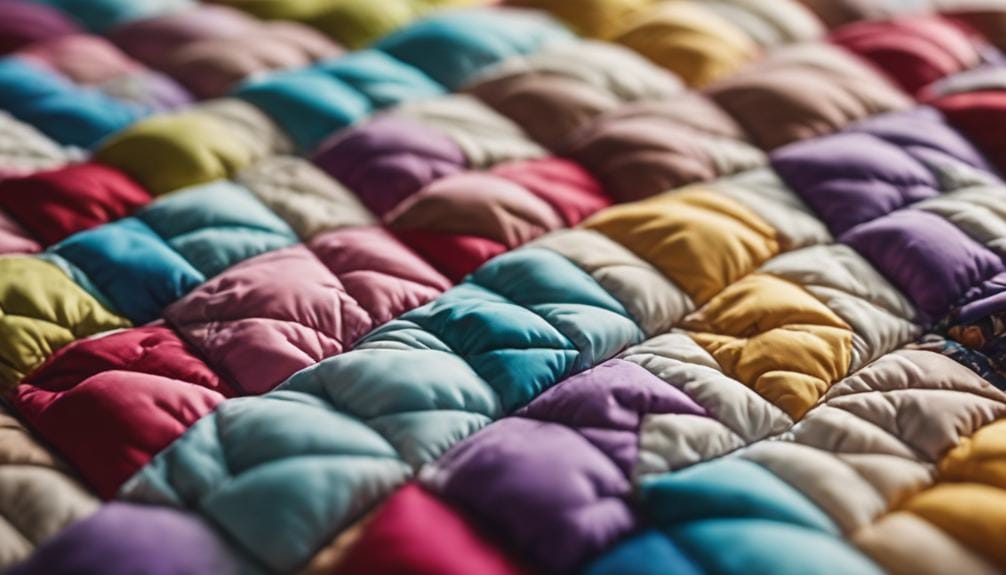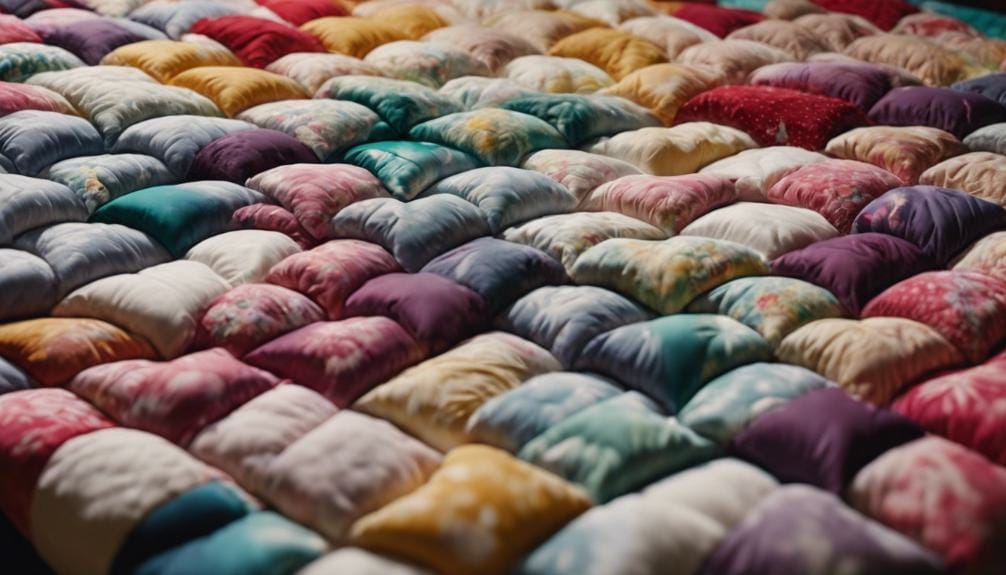Do Cotton Quilts Shrink – Tips & Techniques
When you toss that cozy cotton quilt into the wash, have you ever wondered if it might end up a bit smaller than before?
The potential for cotton quilts to shrink is a common concern for many. Understanding the factors that contribute to this phenomenon and learning how to mitigate it can help you maintain the size and integrity of your beloved quilts.
Stay tuned to discover the secrets to preserving your cotton quilts for years to come.
Key Takeaways
- Cotton quilts shrink due to fibers contracting from moisture and heat.
- Pre-washing fabric and using low-heat settings can minimize shrinkage.
- Understanding cotton shrinkage in the dryer is essential for care.
- Choosing high-quality quilting cotton or polyester batting helps control shrinkage.
Factors Causing Cotton Quilt Shrinkage
Cotton quilt shrinkage is primarily influenced by the inherent tendency of cotton fibers to contract when exposed to moisture and heat. When you use cotton fabric in your quilting projects, it’s essential to understand that this natural fiber is prone to shrinking. The weave of the fabric, the type of cotton used, and the washing process all play a role in determining the extent of shrinkage your quilt may experience.
Pre-washing your fabric before starting your quilt can help minimize surprises and give you more control over the final size of your project. By pre-washing both the cotton fabrics and batting, you can allow them to shrink before incorporating them into your quilt. This step is especially crucial if you plan on combining fabrics of different types or if you’re using pre-cut pieces that may have different shrinkage rates.
When selecting quilting fabric, consider the potential for shrinkage based on the type of cotton used. Different cotton fabrics may have varying shrinkage rates, so understanding how these fabrics behave can help you anticipate and manage shrinkage in your quilt. Additionally, the density of your quilting stitches can impact how much your quilt shrinks, so consider this factor when planning your quilting design. By being mindful of these factors, you can better control the shrinkage of your cotton quilt.
Tips to Minimize Cotton Quilt Shrinkage

To minimize shrinkage in your cotton quilt, consider pre-washing both the fabric and batting before beginning your quilting project. Pre-washing cotton fabrics helps to remove any pre-existing shrinkage and allows you to account for any additional shrinking that may occur during the quilt’s lifespan. Using warm water and a normal dryer setting can also aid in reducing cotton quilt shrinkage. Additionally, opting for low-heat settings when washing and drying your quilt can further prevent excessive shrinkage. Understanding the amount of shrinkage that typically occurs in cotton fabrics can guide you in selecting the appropriate techniques to minimize this effect.
To help you better manage cotton quilt shrinkage, consider the following tips:
| Tips to Minimize Cotton Quilt Shrinkage | Description |
|---|---|
| Prewash your fabric | Removing initial shrinkage from cotton fabrics can help minimize further shrinkage during use. |
| Use low-heat settings | Washing and drying your quilt on low-heat settings can prevent excessive shrinkage. |
| Consider multiple washings for flannel quilts | Flannel quilts may require several washes to reduce potential shrinkage. |
| Opt for polyester batting and pre-washing fabrics | Using polyester batting and pre-washing fabrics can help minimize overall shrinkage in cotton quilts. |
Proper Care for Cotton Quilts

To properly care for your cotton quilt and maintain its size and quality over time, following specific care instructions tailored to cotton fabrics is essential. Cotton fabric is prone to shrinking, but there are steps you can take to minimize this issue. Pre-washing your cotton quilt before construction can help reduce shrinkage post-construction. When it comes to washing your quilt after it’s made, using cold water and air-drying it flat can prevent excessive shrinkage. It’s crucial to avoid high heat settings during both the washing and drying processes to maintain the size of your cotton quilt.
If you prefer a more hands-on approach to caring for your quilt, consider hand-washing it or using a delicate cycle with cold water. This gentle method is kind to the fabric and decreases the risk of shrinkage. Additionally, proper handling and care of your cotton quilt, including pre-shrinking fabrics and batting, can ensure its longevity and size stability. By taking these precautions and following these care instructions, you can enjoy your cotton quilt for years to come without worrying about significant shrinkage issues.
Understanding Cotton Shrinkage in the Dryer

Understanding the natural contraction of cotton fibers in the dryer can help you manage and minimize shrinkage in your quilts effectively. When it comes to cotton quilt shrinkage, here are some key points to consider:
- Cotton Fibers:
Cotton fibers have a natural tendency to shrink when exposed to heat and moisture in the dryer. This shrinkage occurs as the fibers contract, causing the fabric to reduce in size. Understanding this behavior is crucial in dealing with potential shrinkage issues in your quilts.
- Dryer Settings:
The settings on your dryer, such as temperature and cycle duration, can significantly impact the amount of shrinkage your cotton quilt experiences. Lower heat settings and shorter drying times can help minimize shrinkage compared to high heat settings and extended drying periods.
- Prewashing Techniques:
Properly prewashing your cotton fabric before assembling your quilt can help remove any initial shrinkage and set the fibers in place. This step can reduce the likelihood of significant shrinkage occurring later when the quilt is washed and dried.
Best Cotton Materials for Quilts

When selecting materials for your quilting projects, consider the best cotton fabrics known for their breathability and durability. Quilting cotton, such as muslin, Kona cotton, and organic cotton, are popular choices among quilters for their quality. High-quality quilting cotton with a thread count of 60×60 or higher ensures a smooth finish and minimal shrinkage, making it a reliable option for your quilting endeavors.
Pima cotton, renowned for its softness and strength, is another top choice for creating cozy and long-lasting quilts. Its luxurious feel adds a touch of comfort to your quilting projects while ensuring durability over time. Organic cotton fabrics, on the other hand, offer an environmentally friendly option that’s free from harmful chemicals, making them a sustainable choice for those looking to reduce their environmental impact through quilting.
For those concerned about shrinkage, selecting pre-washed cotton fabrics can be beneficial. Pre-washed cotton helps minimize shrinkage issues and ensures consistent sizing in your quilt projects. By choosing the right cotton material, such as quilting cotton, Pima cotton, organic cotton, or pre-washed cotton, you can create beautiful, breathable, and durable quilts that stand the test of time.
Frequently Asked Questions
How Many Inches Will 100% Cotton Shrink?
Cotton can shrink up to 5% in the wash, depending on factors like cotton type and washing conditions. Pre-shrunk cotton may still shrink slightly. Blends with synthetics shrink less. Follow care instructions to minimize shrinkage.
How Do I Keep My Quilt From Shrinking?
To keep your quilt from shrinking, pre-wash and dry all fabric and batting, consider low loft polyester batting, inform recipients about washing instructions, avoid washing quilt tops pre-quilting, and add extra fabric around edges for flexibility.
Will My Quilt Shrink in the Dryer?
Your quilt may shrink in the dryer due to the natural properties of cotton. To minimize shrinkage, pre-wash and pre-shrink the fabric and batting. Use a gentle cycle with cool water and air-dry flat.
Will 100% Cotton Bedding Shrink?
Caring for 100% cotton bedding properly is crucial. Factors like weave type and washing methods can affect shrinkage. Preshrink bedding before use to minimize further shrinkage. Follow care instructions, like washing in cold water, to prevent excessive shrinkage.
Conclusion
In conclusion, it’s important to understand that cotton quilts have the potential to shrink when washed due to factors such as the type of cotton, weave, and heat applied during washing. By following proper care instructions and prewashing fabric, you can minimize shrinkage and maintain the size and quality of your cotton quilt over time.
Choosing high-quality cotton materials can also help prevent excessive shrinkage. Remember to handle your cotton quilt with care to ensure its longevity.



